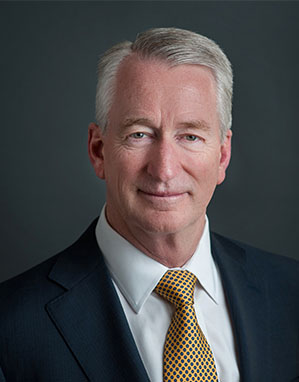Q&A: Lucile Packard Children's Hospital CIO Ed Kopetsky on Embracing Health IT Innovation
When it comes to health IT, Ed Kopetsky has seen it all. The current CIO of Lucile Packard Children’s Hospital Stanford and Stanford Children’s Health has most recently been instrumental in innovative upgrades, such as the move to improve the flow of communication by integrating nurse central stations with patient monitors, the nurse call system and the medical staff’s iPhones. Kopetsky has held this position for about a decade, and has worked at several other prominent health systems as well as in the commercial sector over the course of his long career.

Ed Kopetsky, CIO of Lucile Packard Children’s Hospital Stanford and Stanford Children’s Health. Photo courtesy of Stanford.
Fresh off a win as the Healthcare Information and Management Systems Society CIO of the year, Kopetsky spoke with HealthTech to discuss his greatest challenges, achievements and what he’s learned in his years of work with healthcare IT.
HEALTHTECH: What would you say you’ve learned about working in health IT over the course of your career?
Kopetsky: It’s really not about the technology alone; to be successful, it has to be about significant change to improve healthcare services and patient outcomes. As such, IT needs to be deeply partnered with organizational leadership and operations.
It has worked best to have significant involvement from executives, clinicians and end users from the start of redesign through implementation, optimization and evolution. Because of the opportunity for improving care and business processes, it’s ideal when clinical or business leaders chair the change initiatives, with support and co-leadership from IT.
HEALTHTECH: What was the greatest health IT challenge of your career?
Kopetsky: One of my first, and greatest, health IT challenges was the first time I attempted to automate clinical orders and results in our outpatient clinics. Because the nature of outpatient mobility, location options and timing allowed for follow-up tests, the system we deployed became overloaded with pending orders. We had to back out of the system and redesign it completely. I’m glad that, together with our physicians, we faced the issue quickly and were successful after the redesign.
HEALTHTECH: What about your greatest achievement?
Kopetsky: Our goal at Stanford Children’s Health is to improve healthcare and medicine for children and expectant mothers.
Over the years we have worked in several way to use innovative technology to improve implementation strategies, workflow design, adherence to best practices and patient engagement at Stanford with the aim of achieving those goals. Three such instances include safety interventions for medication administration, the prevention of nephrotoxic acute kidney injury in hospitalized children, and improved care for patients with congenital heart disease through the clinical effectiveness program.
These were three case studies Chief Medical Information Officer Natalie Pageler and I presented to HIMSS for consideration as part of its Davies Award in 2017 — an award given to organizations that demonstrate outstanding achievement in using health IT to improve patient outcomes. Winning was international recognition that we had achieved our goals to improve care for children and expectant mothers. It also attested to why, as an engineer, I chose healthcare as my focus.
HEALTHTECH: What do you see as some of the greatest challenges facing healthcare IT leaders at the moment?
Kopetsky: Following the massive deployment of electronic medical record systems across the country, there is now an unprecedented level of support and integration with clinical operations. It’s also added a burden to our clinicians. We are still learning how to support and optimize clinical workflows, and the budgets supporting IT — not to mention the level of talent required — are a struggle for our health systems.
At the same time, the role of IT in development of new knowledge and the transformation of healthcare to be more accessible and ultimately virtual will significantly increase demand for IT and presents a much broader scope in both executing and developing new strategies. As IT changes, the CIO title and role, along with the scope of IT responsibility, will certainly continue to evolve and grow.
HEALTHTECH: How can healthcare IT leaders effectively engage with each other and other business leaders to address these challenges?
Kopetsky: The best way to engage other business leaders is through collaborative planning and governance. It is essential for IT leadership to partner with clinical and business leaders to clarify needs and IT requirements. In addition, predictable processes are needed to assure common understanding and full transparency. It’s also key for healthcare leaders outside IT to advance their own understanding of IT, in the same way they do with finance, human resources and physician relations.
HEALTHTECH: How can IT leaders best engage with their own IT teams to push innovation throughout an organization, much as you have done?
Kopetsky: First and foremost, the IT organization must be driven by patient care and the business. We have found tremendous value in leveraging Lean principles for continuous improvement, especially those that deal with leadership development, rapid communication, transparency and being in gemba, where the real value is produced.
Our deployment of dedicated IT service area leaders for every major part of our business has been a differentiator because it maximized understanding of needs and a trusted partnership with IT. As a result, we are innovating together with our clinical and business partners throughout the enterprise.
HEALTHTECH: What technologies are you most excited about watching and implementing in coming years?
Kopetsky: Virtual care, including telehealth visits, remote monitoring and emerging sensing technologies will expand greatly in the next five years, and could significantly reduce in-person visits and office overhead costs. At Stanford Children’s Health, we are pursuing innovations in home monitoring programs and wearables, and many of our patients are benefitting from improved access and timely clinical intervention regardless of their location.
Another area to watch is how consumerism and related technologies will alter healthcare and drastically improve access to care and health information. People with long-term needs will be connected continuously to promote proactive care and interventions. With the current FHIR [Fast Healthcare Interoperability Resources] standard, patients at Stanford Children’s can download their electronic medical record to any health app they use.
HEALTHTECH: If you had a magic wand and could change one thing about health IT today, what would it be?
Kopetsky: I’ve long been an advocate for a universal patient ID, which would let us positively identify patients and share vital patient data regardless of where their care is provided.
I also believe we need to restructure our privacy laws to allow easier sharing of critical patient data. This is particularly a barrier and risk to patients afflicted with complex needs, mental health issues and addiction. I would love to see fully connected acute, outpatient and community health services all able to share patient data to support the long-term needs of the patient.










